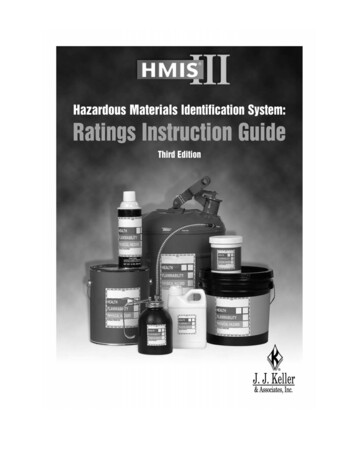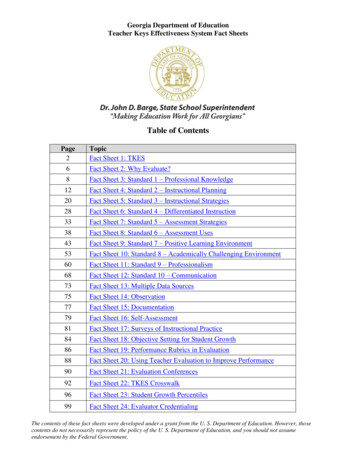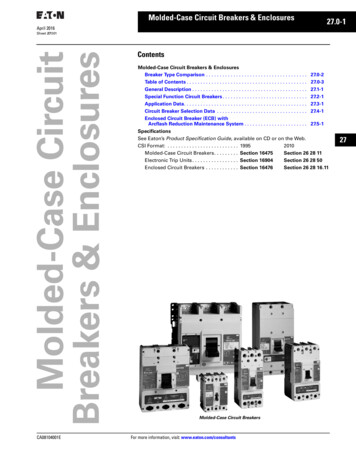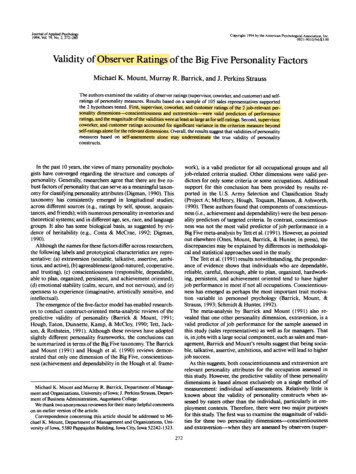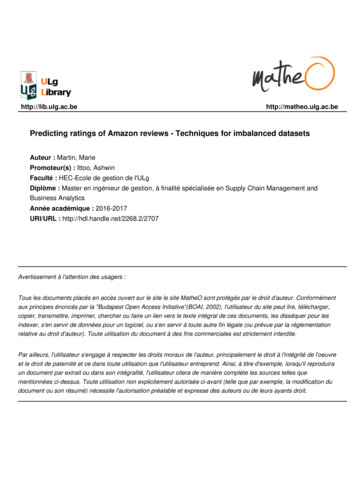
Transcription
ing ratings of Amazon reviews - Techniques for imbalanced datasetsAuteur : Martin, MariePromoteur(s) : Ittoo, AshwinFaculté : HEC-Ecole de gestion de l'ULgDiplôme : Master en ingénieur de gestion, à finalité spécialisée en Supply Chain Management andBusiness AnalyticsAnnée académique : 2016-2017URI/URL : http://hdl.handle.net/2268.2/2707Avertissement à l'attention des usagers :Tous les documents placés en accès ouvert sur le site le site MatheO sont protégés par le droit d'auteur. Conformémentaux principes énoncés par la "Budapest Open Access Initiative"(BOAI, 2002), l'utilisateur du site peut lire, télécharger,copier, transmettre, imprimer, chercher ou faire un lien vers le texte intégral de ces documents, les disséquer pour lesindexer, s'en servir de données pour un logiciel, ou s'en servir à toute autre fin légale (ou prévue par la réglementationrelative au droit d'auteur). Toute utilisation du document à des fins commerciales est strictement interdite.Par ailleurs, l'utilisateur s'engage à respecter les droits moraux de l'auteur, principalement le droit à l'intégrité de l'oeuvreet le droit de paternité et ce dans toute utilisation que l'utilisateur entreprend. Ainsi, à titre d'exemple, lorsqu'il reproduiraun document par extrait ou dans son intégralité, l'utilisateur citera de manière complète les sources telles quementionnées ci-dessus. Toute utilisation non explicitement autorisée ci-avant (telle que par exemple, la modification dudocument ou son résumé) nécessite l'autorisation préalable et expresse des auteurs ou de leurs ayants droit.
PREDICTING RATINGS OF AMAZONREVIEWSTECHNIQUES FOR IMBALANCED DATASETSJury :Promoter :Ashwin ITTOOReaders:Alessandro BERETTAMichael SCHYNSDissertation byMarie MARTINFor a Master’s degree in BusinessEngineering with a specializationin Supply Chain Management andBusiness AnalyticsAcademic year 2016/2017
AcknowledgmentsFirst and foremost, I would like to warmly thank my professor and promoter, Mr. AshwinIttoo, for his time and precious guidance which have been of valuable help throughout thewriting of this dissertation.I also wish to express my gratitude to the members of the jury, Mr. Alessandro Beretta andMr. Michael Schyns, who took the time to read this dissertation.Also, I would like to acknowledge the Scikit-learn and Stack Overflow Communities whoshared precious information and helped me getting more familiar with computer science,machine learning and Python language.Moreover, I would like to thank all the other people who helped me directly or indirectly forthe elaboration of this dissertation.Finally, I am very grateful to my family, friends and my boyfriend for their continuoussupport and encouragement during the completion of this dissertation and throughout thecourse of my studies
Table of contents1. Introduction . 12. Theoretical framework . 52.1 Definition of Machine Learning . 52.2 Distinction between supervised and unsupervised learning . 52.3 Distinction between classification and regression . 62.4 Text classification . 82.5 Text classification algorithms . 102.6 Text classification evaluation . 122.7 Imbalanced datasets . 153. Literature review . 193.1 Importance of online product reviews from a consumer’s perspective . 193.2 Imbalanced distribution of online product reviews . 203.3 Predicting ratings from the text reviews . 233.3.1 Binary classification. 233.3.2 Multi-class classification . 243.3.3 Other approaches . 254. Methodology . 274.1 Approach . 274.1.1 Binary text classification - Approach 1 . 274.1.2 Multi-class classification - Approach 2 . 284.1.3 Logistic Regression - Approach 3. 294.2 Text classification implementation . 294.2.1 Data Gathering . 294.2.2 Choice of the variables. 314.2.3 Data Cleaning. 344.2.4 Data Resampling . 344.2.5 Training a classifier. 374.2.6 Evaluation . 375. Results . 395.1 Videos Games dataset – Experience products . 395.2 Cell phones and Accessories dataset – Search products. 455.3 Discussion . 496. Project Management . 53
6.1 Seminar summary . 536.2 A master thesis seen as a project management approach . 557. Conclusion . 59List of abbreviations. iAnnex 1: Cleaning - Code R . iiiAnnex 2: Sample of annotated reviews . ivAnnex 3: Implementation of text classification - Code Python . viReferences . vii
1. IntroductionNowadays, a massive amount of reviews is available online. Besides offering a valuable sourceof information, these informational contents generated by users, also called User GeneratedContents (UGC) strongly impact the purchase decision of customers. As a matter of fact, arecent survey (Hinckley, 2015) revealed that 67.7% of consumers are effectively influenced byonline reviews when making their purchase decisions. More precisely, 54.7% recognized thatthese reviews were either fairly, very or absolutely important in their purchase decision making.Relying on online reviews has thus become a second nature for consumers.In their research process, consumers want to find useful information as quickly as possible.However, searching and comparing text reviews can be frustrating for users as they feelsubmerged with information (Ganu, Elhada & Marian, 2009). Indeed, the massive amount oftext reviews as well as its unstructured text format prevent the user from choosing a productwith ease.The star-rating, i.e. stars from 1 to 5 on Amazon, rather than its text content gives a quickoverview of the product quality. This numerical information is the number one factor used inan early phase by consumers to compare products before making their purchase decision.However, many product reviews (from other platforms than Amazon) are not accompanied bya scale rating system, consisting only of a textual evaluation. In this case, it becomes dauntingand time-consuming to compare different products in order to eventually make a choicebetween them. Therefore, models able to predict the user rating from the text review arecritically important (Baccianella, Esuli & Sebastiani, 2009). Getting an overall sense of a textualreview could in turn improve consumer experience.Nevertheless, this predictive task presents some challenges. Firstly, because reviews are humanfeedbacks, it may be difficult to accurately predict the rating from the text content. Indeed, usersall have different standards and do not rate a product the same way. For instance a user mayrate a product as good and assign a 5-star score while another user may write the same commentand give only 3 stars. In addition, reviews may contain anecdotal information, which do notprovide any helpful information and complicates the predictive task. Finally the vocabularyused can also be very specific according to the product category.1
The question that arises is how to successfully predict a user’s numerical rating from its reviewtext content. One solution is to rely on supervised machine learning techniques such as textclassification which allows to automatically classify a document into a fixed set of classes afterbeing trained over past annotated data. For instance, when presented to the following review“Amazing movie, I really recommend it, it was one of the best I have ever seen”, we expect a5-star rating to be returned while in the case of “Worst scenario ever, this movie is really bad”,a rating of 1-star is expected.Three different approaches will be presented, namely binary classification, multi-classclassification and logistic regression. More practically, binary classification1 is a simpletechnique and a good baseline to start the investigation as it allows customers to compareproducts that are good or not. On the other hand, using multi-class classification or logisticregression can refine the analysis as it informs the customer on how good the product is (scalefrom one to five), which is an extreme precious information when consumers want to compareseveral products.In this dissertation, three different classifiers (Naïve Bayes, Support Vector Machine (SVM)and Random Forest) that are considered as the state-of-the-art for text classification (Pawar &Gawande, 2012) will be trained on two different datasets from Amazon. Eventually, theperformance of those classifiers will be tested and assessed thanks to accuracy metrics,including precision, recall and f1-score.However, one challenge that cannot be overlooked is the issue of class imbalance. The datasetsare relatively skewed in terms of class distribution. This issue is particularly acute for the caseof binary classification. For instance, there are significantly more reviews with 3, 4 and 5-starratings than there are reviews with 1 and 2 stars (assuming 2 classes, {1, 2 stars} and {3, 4, 5stars}). The issue is still present for the multi-class case, with an over-representation of 5-starratings.We overcome this issue by applying sampling techniques to even out the class distributions.1Ratings are separated into two classes: high and low ratings2
Our main contributions are as follows:-We investigate the performance of state-of-the-art classifiers for addressing the issue ofstar rating prediction of online reviews-We deal with the issue of class imbalance by investigating a number of balancingtechniquesOur results show that the two most successful classifiers are Naïve Bayes and SVM, with aslight advantage for the latter one in both datasets. Binary classification shows quite goodresults (best f1-score of 0.84) while making more precise predictions (i.e. scale from 1 to 5) issignificantly a harder task, our best reported f1-score being 0.57.From a more practical perspective, our approach enables users’ feedbacks to be automaticallyexpressed on a numerical scale and therefore to ease the consumer decision process prior tomaking a purchase. This can in turn be extended to various other situations where nonumerical rating system is available. As an example, it can be used in order to predict ratingsfrom articles or blogs related to books or movies or even comments on YouTube or Twitter.This dissertation is structured as follows.We will start by giving key information regarding machine learning and more specifically textclassification.In chapter 3, we analyze the information available in the literature. Aside from figuring out howconsumers are effectively using product reviews and their associated star-ratings to makepurchase decisions as well as emphasizing on the imbalanced distribution of the online reviews,this chapter outlines the different approaches undertook by researchers to predict ratings fromthe text content of reviews.Chapter 4 is devoted to the methodology and the implementation of the predictive task. Afterpresenting the chosen approaches, we explain how data was collected and cleaned. Then weidentify the variables of interest and focus on the resampling step in order to cope with theimbalanced structure of the data. Finally, we describe the two main steps of text classification,namely training and testing.Afterwards, chapter 5 presents the results obtained from the implementation of this predictivetask. We compare the different models for the two datasets based on standard performancemetrics.3
The objective of chapter 6 is to explain how this dissertation falls within the framework of astructured project management approach such as exposed during the seminar given by JeanPierre Polonovski.Finally, chapter 7 will summarize the different approaches investigated in this dissertation aswell as the results obtained and propose some practical applications of the model. Eventually,a few suggestions will be recommended for further improvements and future research.4
2. Theoretical frameworkThis chapter aims at briefly introducing and defining key concepts in relation to machinelearning that are relevant to the topic of this dissertation. More precisely, machine learning andits terminology will first be defined. Secondly, a distinction between supervised andunsupervised learning will be made. Also, the terms classification and regression will bedistinguished. Afterwards, the emphasis will be put on the definition of text classification, theway it can be modeled and assessed. Finally, the subject of imbalanced datasets will beaddressed.2.1 Definition of Machine LearningAccording to Awad and Khanna (2015), “Machine learning is a branch of artificial intelligencethat systematically applies algorithm to synthesize the underlying relationships among data andinformation”.In the field of machine learning, data are stored in tabular format. Each row is known as a record(also named as instance or observation) while each column is known as an attribute (also knownas feature or input).2.2 Distinction between supervised and unsupervised learningThere are two main categories of machine learning: supervised and unsupervised learning.Supervised learning (also known as predictive modeling) is the process of extractingknowledge from data to subsequently predict a specific outcome (binary or any level) in anew/unseen situation. Note that the features used to predict the class are named the independentvariables, whereas the predicted class is known as the dependent variable (also named asresponse, target or outcome).More precisely, the two main steps of supervised learning, also depicted in Figure 2.1, are thefollowing ones:a) Learn a model from the dataset composed of annotated data. This step is calledtraining because the model is learning the relationship between the attributes of the data(inputs) and its outcome (output).b) Use the model to make accurate predictions on new (unseen) data. This step enablesto test the developed machine learning algorithm.5
In other words, the primary goal of supervised learning is to model an input-output systembased on labeled data that accurately predicts the future data.Figure 2.1: Supervised machine learning model2Supervised learning has numerous applications in various domains ranging from diseasediagnostic tools based on biological and clinical data of a patient to financial market analysis.In contrast, unsupervised learning is the process of extracting structure from data or to learnhow to best represent data. In this case, instances do not have pre-defined classes as targetoutputs (unknown outputs). The aim of unsupervised learning tasks is to discover patterns ordetect any association between features in unlabeled datasets. Two widespread examples ofunsupervised learning are clustering (grouping similar instances into clusters) anddimensionality reduction.This dissertation will primarily focus on supervised learning.2.3 Distinction between classification and regressionAs a reminder, three types of variables can be differentiated:-Binary variables, taking only two different values-Categorical variables, taking two or more possible nominal values.Note that a binary variable is also a categorical variable.-2Numerical variables whose values are numbersSource : ntroduction-to-machine-learning.php6
Depending on their output domains, supervised learning tasks can be classified into twocategories:-Classification tasks, which either have binary outputs or categorical outputs, meaningthat the class to be predicted takes on a finite set of nominal values.Classification consists in assigning new, previously unseen instances to a predefinedclass, based on the knowledge acquired by training over past data, annotated with theirrespective classes.-Regression tasks, which take on numerical outputs. The class to be predicted is orderedsuch as the price of a building or the high of a person.Regression is a process that estimates the relationship between a dependent variable Y(output) and one or more independent variables X (inputs). More precisely, regressionaims at understanding how the dependent variable is affected by the variation of theindependent variables.Two types of regression can be observed. While in the linear regression, the outcomeis continuous, the logistic regression only takes on discrete target values and thus onlyhas a limited number of possible values to be predicted. Despites its name, logisticregression is a model used for classification problems and is used to estimate theprobability to pertain to a specific class.Figure 2.2: Comparison between Linear Regression and Logistic Regression33Source: Lecture notes of Business Analytics.7
2.4 Text classificationAs mentioned previously, classification is a supervised machine learning task which aims atcreating a model to make predictions. This model is trained on annotated past data.Text classification, also known as text categorization, is an extension of the classificationproblem over structured data. According to Sebastiani (2002), given a collection of documents,D, and a fixed set of classes C, the aim is to learn a classifier γ using a classification algorithmand predict the best possible class c C for each document d.Instead of manually assigning a class to each document, which can be extremely timeconsuming, text classification enables to automatically decide which predefined category thetext document belongs to, based on human-labeled training documents.Sebastiani (2002) also separates text classification problems into different types based on thenumber of classes a document can belong to:-Binary classification: there are exactly two classes and each document belongs to oneclass or the other, i.e. simple sentiment analysis (positive or negative), spam filtering(spam or non-spam).-Multi-class classification: there are more than two classes (categorical outputs) andeach document belongs to exactly one single class. Two types of multi-classclassification are observed:a) Non-ordinal classification, where C {c1, , cn}, with n 2, i.e. movie genreclassification (action, comedy, drama, etc.)b) Ordinal classification, where C c1 cn , with n 2, i.e. product reviewsclassification (1-star, 2-star, 3-star, 4-star or 5-star) where the first class isconsidered as the worst and the last one as the best.Note that binary classification is a special case of multi-class classification.-Multi-labels classification: there are more than two classes and each document canpertain to one, several, or none of these classes, i.e. an article can treat the subject offinance, politics and economy at the same time or none of these.8
In our work, all reviews can belong to exactly one class. Thus, our task is that of multi-classclassification. It can also be reformulated as a binary classification by grouping the classes, fore.g. {1, 2 stars} and {3, 4, 5 stars}. The case of multi-label is therefore not applicable to us.In order to apply text classification, the unstructured format of text has to be converted into astructured format for the simple reason that it is much easier for computer to deal with numbersthan text. This is mainly achieved by projecting the textual contents into Vector SpaceModel, where text data is converted into vectors of numbers.In the field of text classification, documents are commonly treated like a Bag-of-Words(BoW), meaning that each word is independent from the others that are present in the document.They are examined without regard to grammar neither to the word order4. In such a model, theterm-frequency (occurrence of each word) is used as a feature in order to train the classifier.However, using the term frequency implies that all terms are considered equally important. Asits name suggests, the term frequency simply weights each term based on their occurrencefrequency and does not take the discriminatory power of terms into account. To address thisproblem and penalize words that are too frequent, each word is given a term frequencyinverse document frequency (tf-idf) score which is defined as follow:t𝑓 id𝑓𝑡,𝑑 t𝑓t,d id𝑓twhere: t𝑓t,d nt,d 𝑘 𝑛𝑘,𝑑with nt,d the number of term t contained in a document d, and 𝑘 𝑛𝑘,𝑑 the total number of terms k in the document d 𝑁id𝑓t log 𝑑𝑓 with N the total number of documents and dft the number of documents𝑡containing the term tTf-idf reflects the relative frequency of a term in a set of documents. Therefore, a wordoccurring too often in a set of documents will be considered as less significant while a wordappearing only in a few documents will be regarded as more important.4The Bag-of-word model presents two major weaknesses. It ignores the order of words as well as the semanticrelation between words. An alternative to cope with this issue is to consider the n-gram model, which can be seenas all the combinations of contiguous words of length n in a text document. It is called a unigram when the valueof n is 1 and a bigram when n equals to 2.9
Other features can be used in the framework of text classification such as part-of-speech (POS)which consists in translating words into their nature (e.g. noun, adjective, verb and so on).Finally, text categorization has numerous and widespread applications in the real world such asopinion mining, language identification or genre classification.To recap, 4 steps are essential to develop a text classification algorithm:1) Structure the data2) Chose the most pertinent features. Commonly, the words with the higher tf-idf scoreswill be selected.3) Use these features to train a classification algorithm4) Evaluate the trained classifier to determine its predictive accuracy2.5 Text classification algorithmsText classification can be performed using different algorithms. In this context, algorithmsimplementing classification are called classifiers. In this section, only the most used classifiersfor text classification (Pawar & Gawande, 2012) will be presented.a) Naïve-Bayes: this popular text classification technique predicts the best class (category)for a document based on the probability that the terms in the document belong to theclass. The principle on which this classifier relies is called Maximum A Posteriori(MAP). From a mathematical point of view, the probability to predict a class c to adocument is:𝐶𝑚𝑎𝑝 𝑎𝑟𝑔𝑚𝑎𝑥 𝑃̂(𝑐) 𝑃̂ (𝑡𝑘 𝑐)𝑐 𝐶1 𝑘 𝑛𝑑where: 𝑃̂(𝑐) is the probability that a document belongs to class c (based on the trainingdata), also called class prior probability 𝑃̂(𝑡𝑘 𝑐) is the probability of a term t at position k in d to be observed indocuments from the class c nd is the number of terms in d10
e5andpositionalindependence6), the multinomial Naïve-Bayes classifier works reasonably well inpractice (Zhang, 2004).b) Support Vector Machine (SVM): this classifier, in the case of binary classification, istrying to find the best hyper plane to divide data into two classes, knowing the place ofeach data item in the dimensional space. As depicted in Figure 2.3, its basic goal is tomaximize the margins, i.e. the distances between the hyper plane and the closest pointsfrom each class. When presented to new data points, the classifier assigns a specificclass based on their position relative to the optimal hyper plane.SVM is considered as one of the best text classification algorithms (Joachims, 1998),even though its running time can be slower than Naïve Bayes.Figure 2.3: Support Vector Machine representation7c) Random Forest: this classifier is a meta estimator that independently builds a multitudeof decision tree classifiers on different sub-samples of the dataset to subsequentlyaverage their predictions. Doing so enables to increase the predictive accuracy8 andrestrain over-fitting.5Terms are independent of each other given the class meaning that the occurrence of one word does notdepend on the occurrence of another word6The order of words is considered as irrelevant, which is equivalent to adopting the bag-of words model7Source : uction to svm/introduction to svm.html8Because its variance is reduced11
2.6 Text classification evaluationK-fold cross validation is the most commonly used method in order to evaluate theperformance of a classifier.With this method, the dataset is partitioned into K equally-sized disjoint folds. For each of theK iterations, the training set is composed of the examples from (K-1) folds aiming at trainingthe classifier whereas the examples of the remaining fold represent the testing dataset, used toevaluate the classifier. Each iteration gives a value of error, which is used for the computationof the overall true error estimate.The main advantage of this method is that each record appears at least once in the trainingdataset, and at least once in the testing dataset. Therefore, we ensure to train and test the wholedataset.In practice, the value of K is set to either 5 or 10 depending upon the size of the dataset. Laterin the analysis, K will be equal to 10. The 10-fold cross validation method is illustrated inFigure 2.4.Figure 2.4: 10-fold cross-validation representation99Source : https://www.google.de/search?q 10 fold crossvalidation&client firefox-bab&source lnms&tbm isch&sa X&ved 0ahUKEwivtISaxt7TAhWFuRoKHc8VDugQ AUICigB&biw 1366&bih 659#imgrc 6AgLJhf9JQ Q3M:12
Assessing the performance of algorithms is essential as it illustrates how well the algorithmperforms in its classification and also helps choosing the more accurate classifier. The outputquality (prediction performance) of a supervised learning model can be evaluated throughdifferent metrics that can be best understood with a confusion matrix.A confusion matrix compares the actual classification against the predicted classification foreach binary classification problem.Predicted PositivePredicted NegativeActual PositiveTPFNActual NegativeFPTNFigure 2.5: Confusion matrixFour categories of predictions can be encountered:-True Positive (TP): predictions accurately predicted as positive-True Negative (TN): predictions accurately predicted as negative-False Positive (FP): predictions incorrectly predicted as positive (predictions thatshould be negative but were predicted as positive)-False Negative (FN): predictions incorrectly predicted as negative (predictions thatshould be positive but were predicted as negative)In brief, in the two last cases, the model wrongly predicts the samples.From this confusion matrix, some metrics assessing the quality of a classifier can be computed:𝐹𝑃 𝐹𝑁-𝐄𝐫𝐫𝐨𝐫 𝐫𝐚𝐭𝐞
Gawande, 2012) will be trained on two different datasets from Amazon. Eventually, the performance of those classifiers will be tested and assessed thanks to accuracy metrics, including precision, recall and f1-score. However, one challenge that cannot be overlooked is the issue of class imbalance. The datasets
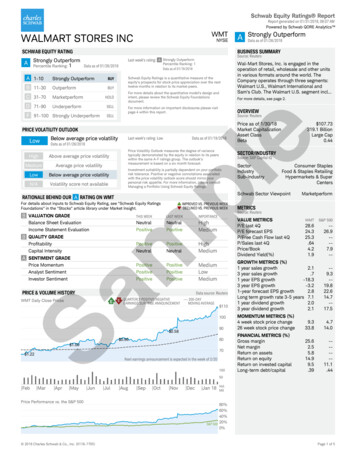

![Index [beckassets.blob.core.windows ]](/img/66/30639857-1119689333-14.jpg)
